Applying for scholarships is a big step in your education. You often need a bonafide certificate to show you’re eligible. This certificate proves you’re really a student at your school.
In this guide, I’ll show you how to write a good application for a bonafide certificate. This will help you get scholarships.
Key Takeaways
- Bonafide certificates are key for scholarships, internships, and more.
- “Bonafide” means your student status is real and true.
- There are sample templates and tips to write a great bonafide certificate request.
- Make sure to check your work and be polite when following up.
- Bonafide certificates are needed for many scholarships, like for undergrads, grads, and more.
Understanding Bonafide Certificates and Their Importance
A Bonafide Certificate is a document from schools that shows a student is in a certain class or program. It’s very important for scholarship applications. It proves a student’s school status and if they can get a scholarship.
Definition of Bonafide Certificate
This certificate has the student’s name, roll number, what they’re studying, and how long they’ve been there. It’s legal and accepted by many places for things like enrollment verification, student records, and official transcripts.
Role in Scholarship Applications
For students looking for scholarships, this certificate is key. It shows they are in school and doing well. Scholarship groups use this info to see if a student is a good fit.
Legal Validity and Recognition
The Bonafide Certificate is a real document that matters. Schools, banks, government, and more accept it. It proves a student is in school and doing well.
“70% of student visa applications require a Bonafide Certificate to prove enrollment at a recognized educational institution for studying abroad.”
This certificate is important for many things. It helps with school loans, internships, and jobs. Its legal status and wide acceptance make it very important.
Essential Components of a Bonafide Certificate Request
Getting a bonafide certificate is key for students looking for scholarships. It proves you’re in school and doing well. When you ask for one, make sure to include all the important details.
The main parts of a bonafide certificate request are:
- Your full name as it appears on your academic records
- Your unique student roll number or identification number
- The course of study you are currently pursuing
- Your current year or semester of enrollment
- The purpose of the bonafide certificate, such as a scholarship application
- Any specific requirements or instructions from the scholarship committee
Make sure to send your request to the right person at school. This could be the principal, head of department, or registrar. This way, your application gets to the right place.
If there’s a deadline for the scholarship, tell the school about it. This helps them get your certificate to you on time.
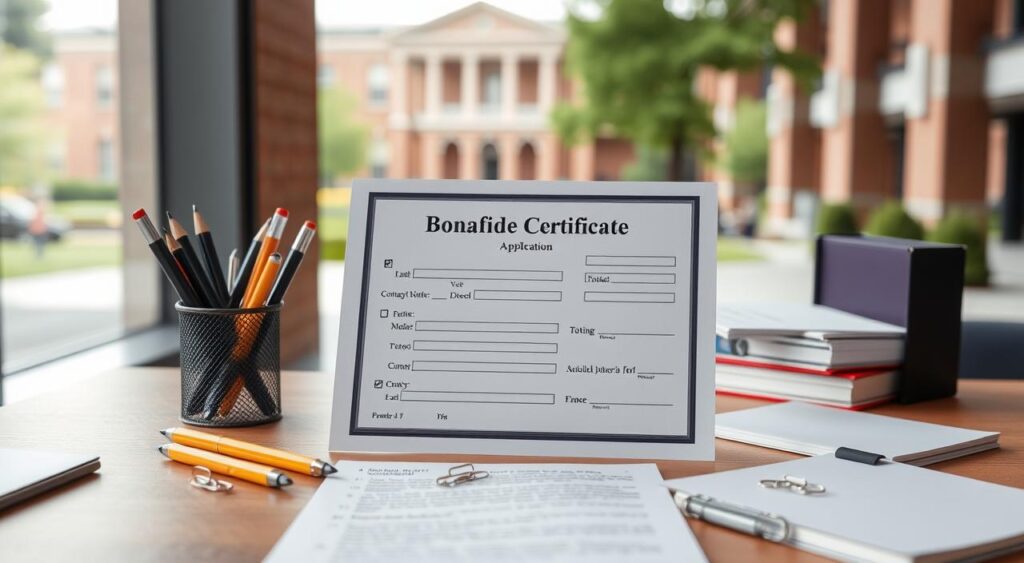
By adding these important details to your request, you make the process easier. This increases your chances of getting the certificate you need for your scholarship application.
Step-by-Step Guide: How to Write Application for Bonafide Certificate for Scholarship
Getting a bonafide certificate is key for scholarship applications. It proves you’re a student and shows your grades. To make your application go smoothly, follow this guide.
Proper Formatting Guidelines
Start with a formal hello, like “Dear [Appropriate Authority].” Say why you need the certificate, like “I am writing to request a bonafide certificate” or “I need a bonafide certificate for my scholarship application.”
Required Personal Information
- Give your full name, roll number, and what you’re studying.
- Include your department or faculty and how long you’ve been there.
- Tell them when you need the certificate by.
Writing Style and Tone
Be professional and polite in your application. Don’t use slang or casual talk. Keep it short and clear, with only the important info. Check your application for mistakes before you send it.
By following these tips, you’ll write a great application for your bonafide certificate. This will help you with your scholarship.

Required Documents and Prerequisites
Getting a bonafide certificate is easy, but needs vary by school or group. Make sure you have all needed papers and meet any rules set by the issuer.
Students usually need to fill out a form, show their student ID, and prove they paid their fees. These steps confirm they are enrolled and have paid their fees.
Employees might have to show their latest pay slip and work ID. This proves they work there and are part of the team.
Some places also want students or workers to be doing well academically or professionally. They should not have unpaid fees or problems. Always check with the place you’re applying to about their financial aid requirements and student records.
Temporary bonafide certificates last up to six months and can be renewed. Permanent ones last longer, great for ongoing needs.
Some places might ask for a small fee for the certificate. Be ready to pay this when you apply.
“Bonafide certificates serve as a key link between people and the places they work or study. They help with many important tasks.”
By getting the right papers and meeting the rules, you can apply for your bonafide certificate easily. It’s useful for school, work, or other reasons.
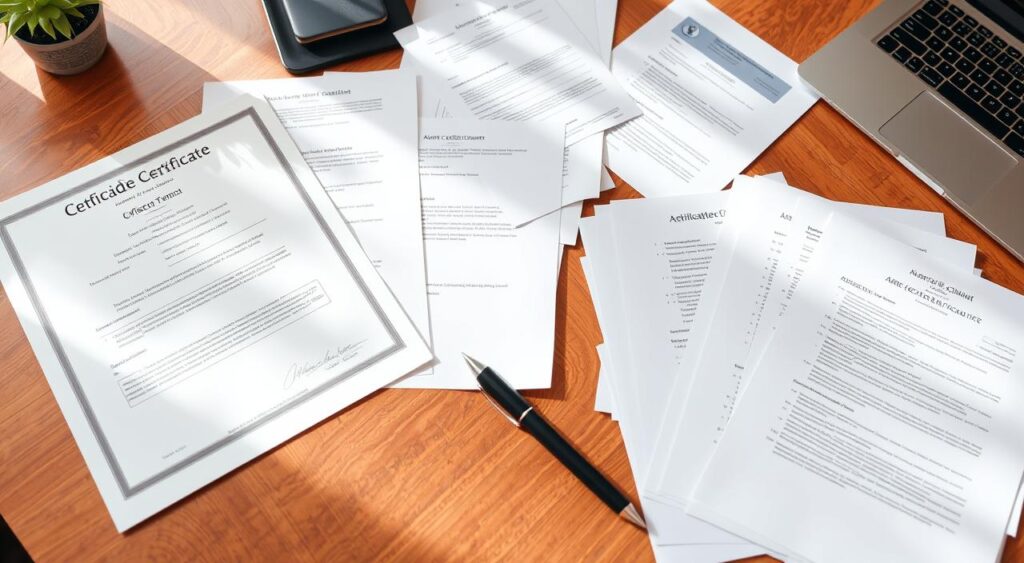
Formatting Your Application Letter Professionally
When you write your application for a bonafide certificate, make it look professional. This shows you pay attention to details. It also makes the university take your request seriously.
Header and Date Placement
Start by putting your full address and today’s date in the top right corner. Make sure it looks neat and organized. Don’t put too much in this area. Keep it simple and nice to look at.
Body Structure Guidelines
Then, write the letter to the right person, like the Principal or Registrar. Use a formal greeting like “Dear [Title] [Name].” Say right away why you’re writing. Explain you need a bonafide certificate for your student application to a scholarship.
In the main part of the letter, share your academic info. Include your name, student number, what you’re studying, and how long you’ve been at the university. Also, talk about any deadlines or special needs for the scholarship.
Closing Remarks Format
End the letter with a formal sign-off, like “Sincerely” or “Yours faithfully.” Add your full name and how to reach you. This shows you’re polite and professional. It also gives the recipient a way to get in touch with you if they need to.
Use the same font, size, and spacing throughout. This makes your letter look good and easy to read. Paying attention to these details helps your student application for the bonafide certificate get handled quickly.
Common Mistakes to Avoid in Your Application
Applying for a bonafide certificate is a big step for scholarship eligibility. But, you must avoid common mistakes to keep your academic record safe. Here are some errors to watch out for to make sure your application goes smoothly:
- Addressing the Wrong Authority: Always send your request to the right person at your school. This could be the registrar or principal. If you don’t, your application might get stuck.
- Providing Incomplete Information: Make sure you fill out every part of the application. This includes your personal info, school history, and why you need the certificate. Leaving out important details can cause your application to be turned down.
- Using Informal Language: Keep your application formal and professional. Stay away from slang or casual words. Use a respectful and proper tone instead.
- Failing to Clearly State the Purpose: Be clear about why you need the bonafide certificate. It could be for a scholarship, visa, or something else. This helps the school understand why you need it.
- Neglecting to Include Contact Information: Always give your current contact info. This includes your phone number and email. This way, the school can get in touch with you if they need to.
- Submitting the Application Late: Don’t wait until the last minute to apply. The school might take some time to process it. Applying late could hurt your chances for a scholarship.
- Failing to Follow Up: If you don’t hear back in time, follow up with the school. Checking on your application can help it get done faster.
By avoiding these mistakes, you can get a good bonafide certificate. This will help with your scholarship and school records.
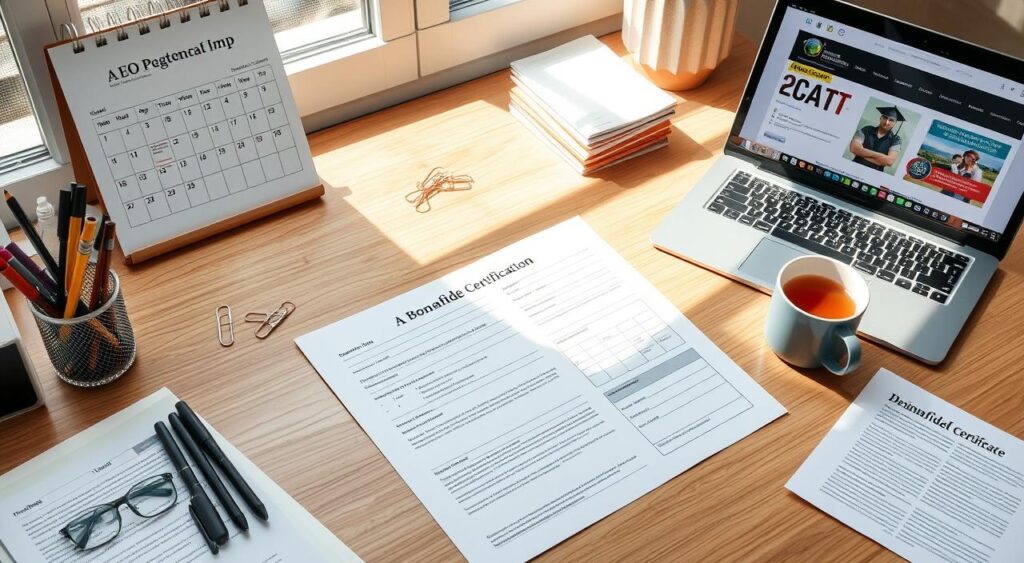
Remember, being careful and professional is important when asking for a bonafide certificate. Follow these tips to increase your chances of success.
Different Types of Scholarship Bonafide Certificates
When you apply for scholarships, you need to know about bonafide certificates. The type needed depends on your education level and the scholarship. Knowing about these certificates helps you give the right documents for your application.
Undergraduate Bonafide Certificates
Undergraduate certificates prove you’re in school and what year you’re in. They list your name, program, and year. They show you’re in an undergraduate program.
Postgraduate Bonafide Certificates
Postgraduate certificates have more info than basic ones. They might talk about your research or thesis. This shows your focus and skills in your studies.
International Scholarship Bonafide Certificates
For international scholarships, certificates need more details. They might list your course length, teaching language, and more. Giving all the needed info is key for a good application.
It’s vital to match your bonafide certificate with the scholarship’s needs. Proper enrollment verification and detailed university documentation are very important.
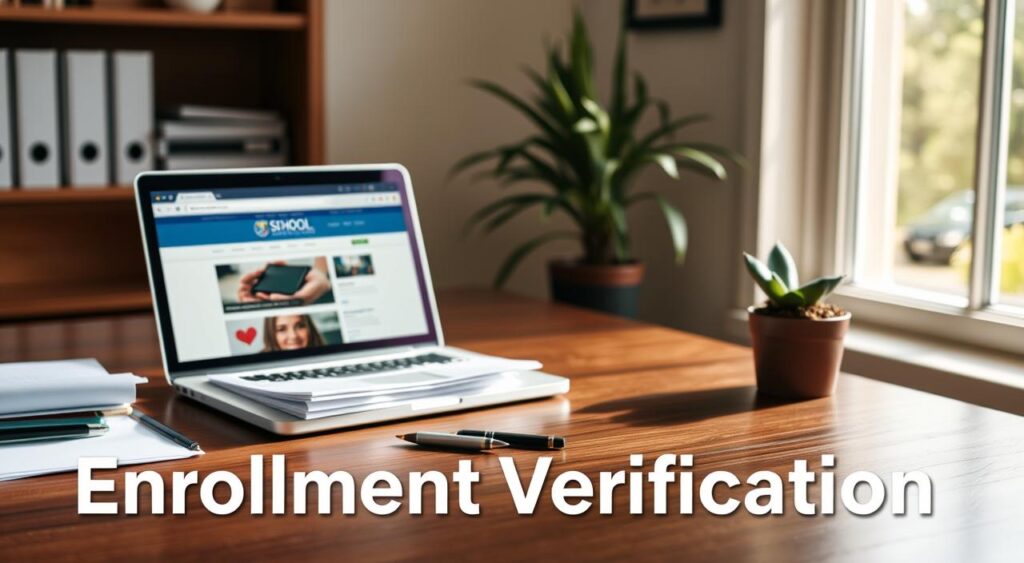
“Bonafide certificates are essential for students enrolling in educational institutions or for individuals in the employment sector to provide evidence of their affiliations and experiences.”
Addressing the Right Authority
When you apply for a bonafide certificate for scholarships, it’s key to send it to the right person. This makes sure your application gets to the right person. It also helps get a quick and good answer.
At school, send your application to the Principal. For colleges, it’s the Head of Department or the Dean. Universities usually send it to the Registrar or the scholarship office.
If you’re not sure who to send it to, call your school’s admin office. Using the right title and name shows you’re serious. It helps your application get noticed.
| Institution | Authority to Address |
|---|---|
| School | Principal |
| College | Head of Department or Dean |
| University | Registrar or Scholarship Office |
By sending your student application or university documentation to the right person, you make sure it’s handled well. This boosts your chances of getting the scholarship you want.
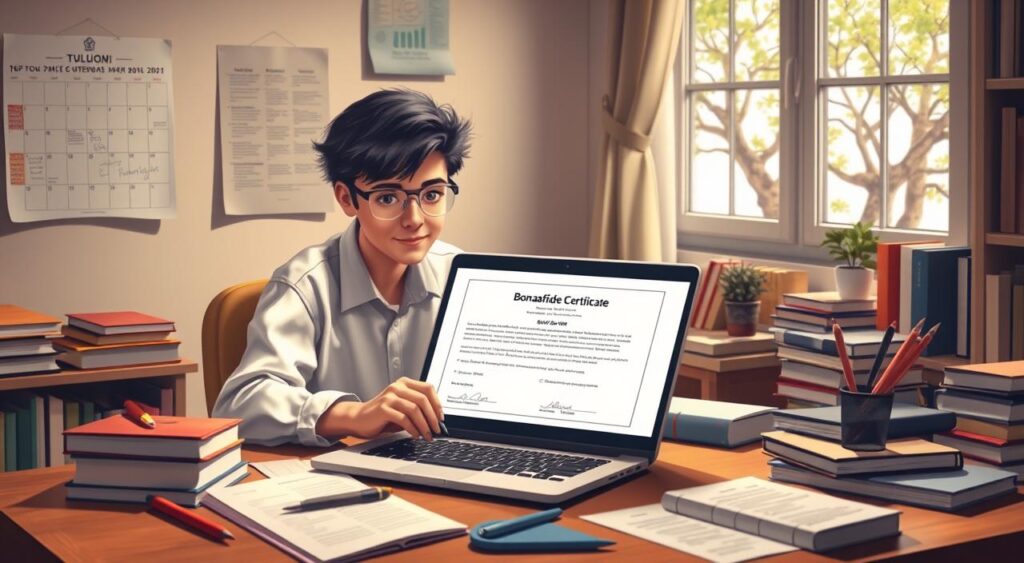
Timeline and Processing Expectations
When you’re looking for academic scholarships, knowing how long it takes to get a bonafide certificate is key. It usually takes 3 to 7 days, but it’s best to ask early in the school year. This way, you avoid any delays.
Bonafide certificates are very important for scholarship applications. They show you’re enrolled in school. They have your name, birthdate, and school info. Making sure this info is right helps your application go smoothly.
Emergency Request Procedures
Sometimes, you need a bonafide certificate fast for a scholarship. Schools can do this quickly, but it might cost more. If you’re in a hurry, tell them and try to talk to them in person. Bring proof of your deadline to help speed things up.
| Statistic | Value |
|---|---|
| Estimated population of OBCs | 41.7% as per NSSO (2009-10) 66th Round |
| OBCs below the poverty line | 21.9% as per the Planning Commission’s report 2011-12 |
| Pre-Matric Scholarship financial assistance | Rs. 4,000 per annum |
| Annual income eligibility for scholarship | Not exceeding Rs. 2.50 lakh per annum |
| Attendance requirement for scholarship renewal | 75% |
| Attendance verification | Aadhaar-based attendance system |
| Scholarship duration | Available for only one year per class |
Knowing how long it takes to get a bonafide certificate helps you with your scholarship eligibility and academic credentials. This makes your application process smoother. It also increases your chances of getting the financial help you need.

Following Up on Your Application
Applying for a bonafide certificate is key for student records and more. But, it doesn’t stop after you apply. You must follow up to make sure it’s being done right.
If you don’t hear back, don’t worry. Wait 3-4 workdays before asking. This gives them time to check your request.
To follow up, you can go in person or email. Remember your application date and number. Be nice and patient, as delays happen.
Being active and not giving up helps a lot. You’ll get your certificate faster, meeting your needs sooner.
“Persistence and determination alone are omnipotent. The slogan ‘Press On’ has solved and always will solve the problems of the human race.” – Calvin Coolidge
Getting bonafide certificates is vital for students and workers. By following up, you’re on the right path to getting what you need.
Sample Templates for Different Educational Levels
Getting a bonafide certificate is key for scholarships. But, the details needed change with your level of study. We’ve made sample templates for school, college, and university levels to help.
School Level Template
At school, a parent or guardian can write the request. It should list the student’s name, class, and roll number. Also, say why you need the certificate, like for a scholarship.
College Level Template
College requests are more detailed. They need the student’s name, course, year, and roll number. Also, include the purpose of the certificate and any scholarship info.
University Level Template
University requests are formal and detailed. List the student’s name, course, year, and roll number. Mention the purpose of the certificate and any scholarship details.
It’s key to follow the right format and give all needed info. Keep your tone professional but polite. These templates will help make your application strong and boost your scholarship chances.
| Educational Level | Key Components | Tone and Formality |
|---|---|---|
| School | Student’s name, class, roll numberPurpose of certificate (e.g., scholarship) | Informal, written by parent/guardian |
| College | Student’s name, course, year, roll numberPurpose of certificateScholarship details (if applicable) | Formal, written by student |
| University | Student’s name, course, year, roll numberPurpose of certificateSpecific scholarship or program details | Formal, written by student |
Use these templates to make your bonafide certificate request for your student application stand out. It will help you get the documents you need for scholarships.
Digital Submission vs. Physical Application
Many Indian universities now accept Bonafide Certificate requests online. This makes it easy for students to apply without going to campus. Online submissions are often quicker and let you track your request.
But, some places need you to apply in person. This way, they can keep official records. If you need to apply in person, use good paper and go there yourself.
It’s important to follow the rules for your university. For online submissions, make sure your files are clear and in PDF. For in-person applications, keep everything neat and include all needed documents. Following these steps helps your application go smoothly and quickly.
FAQ
What is a Bonafide Certificate?
A Bonafide Certificate is an official document. It shows a student is really in school. It’s needed for things like scholarships and internships.
How important is a Bonafide Certificate for scholarship applications?
It’s very important. It proves you’re in school and doing well. It’s needed for scholarships.
What key information is included in a Bonafide Certificate?
It has your name, roll number, and what you’re studying. It also shows how long you’ve been there.
What should be included in a Bonafide Certificate request application?
You need your name, roll number, and what you’re studying. Also, why you need the certificate and any special rules from the scholarship committee.
How do I format a Bonafide Certificate request application?
Start with your address and date at the top right. Be formal and clear. Use a polite closing and include your contact info.
What documents are typically required for a Bonafide Certificate application?
You’ll need a filled-out form, a copy of your ID, and proof of payment. If you work there, you might need a payslip and work ID.
What common mistakes should I avoid in my Bonafide Certificate application?
Don’t send it to the wrong person or leave out important info. Use proper language and include your contact info. Don’t be late and follow up if needed.
How do Bonafide Certificates vary based on educational level and purpose?
They change based on your level and why you need it. Undergraduate ones show you’re enrolled. Postgraduate ones might list your research. International ones need more details.
To whom should I address my Bonafide Certificate request application?
It depends on your school. For schools, it’s the Principal. Colleges go to the Head of Department or Dean. Universities might need you to send it to the Registrar or scholarship office.
How long does it take to process a Bonafide Certificate request?
It usually takes 3-7 days. Some places offer fast service for extra money.
What should I do if I don’t receive a response within the expected timeframe?
If you don’t hear back, send a polite follow-up. Wait a few days first. You can email or visit in person.
Are there any sample templates available for Bonafide Certificate request applications?
Yes, there are templates for schools, colleges, and universities. They have the right format and polite closing.
Can I submit my Bonafide Certificate request application digitally?
Many places accept digital applications. But, some might want a paper copy. Check with your school.